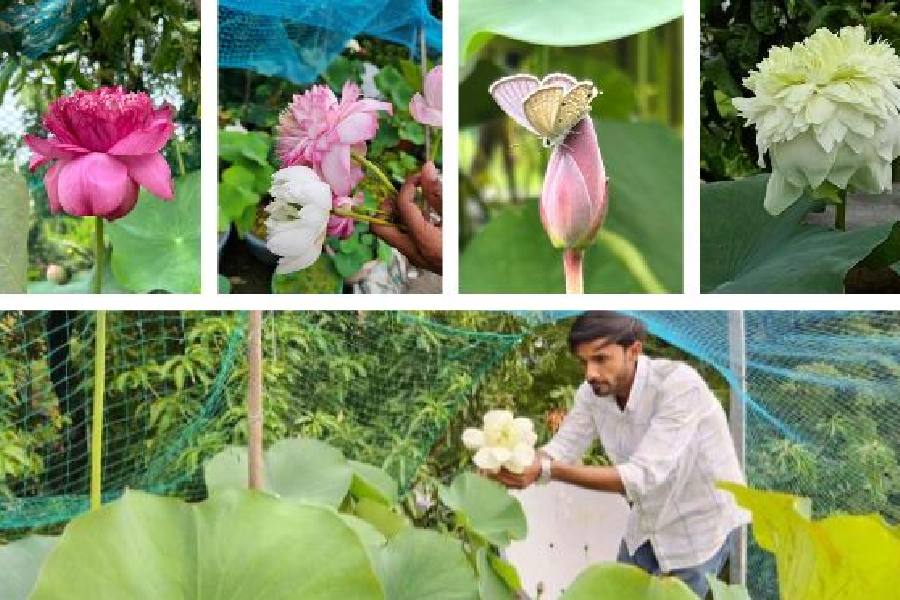Do you admire the serenity of Lotus blooms in ponds and wish to have one of your own? While you can’t turn your terrace into a pond, there’s still a lot you can do to get a close enough experience.
A case in point is a terrace curated by Debjyoti Chakraborty. Better known as a priest — he offers prayers at the temple in IA Market the one outside CK Market — Chakraborty is also a gifted green thumb.
“Lotus is a flower that can be offered to every god at every puja. I love growing them and offer them at temples as well as gift them to people. It is a great hobby that everyone can pursue,” he says the resident of Purbachal Cluster X.
Here are some tips Chakraborty shared with The Telegraph Salt Lake for those who want to grow a Lotus garden on their terrace or front yard.
Prepare planting medium: Choose a bucket that is two feet deep and two feet wide. Start by filling it with half an inch of gobor shaar or vermicompost. Next, add a two-inch layer of soil. Plant the tuber (see next point), then cover it with an additional inch of soil. Finally, fill the bucket to the brim with water.
Ensure the plant receives six to eight hours of direct sunlight daily. Change the water once a week, taking care not to disturb the soil at the bottom.
Pick a tuber: It is tough to propagate Lotus from seeds; using tubers is the best and fastest method. Tubers are underground stems that you can buy for Rs 600 to Rs 3,000, depending on the Lotus variety. But then it’s not necessary to buy new tubers each time, as a single tuber can produce multiple plants later on.
When to pot: Lotuses are perennials. They go through a cycle of growth, dormancy in winter, and then re-emerge the next season.
In our climate, it is best to start potting Lotuses in January. If all goes well, they would start flowering by April and continue until October, after which they would enter dormancy due to the cold.
By April or May, standing leaves would have sprouted. Now add DAP or NPK fertiliser in the ratio of 10:26:26, sowing four or five pellets in the soil bed away from the growing tuber.
During extremely hot weather, like we faced this summer, water the plants twice a day. The water will keep evaporating but you must refill it so the bucket stays full to the brim. During the monsoon, the rains will maintain the water level.
You may cover the plants with a net to prevent birds from pecking at them.
The right variety: Today, I grow multiple Lotus varieties, including Mohong, Buddha Seat, White Buddha, and Pror Pink. But my first Lotus did not survive. I had bought a tuber of the Hundred Petal variety for Rs 1,200 but learned too late that it wasn’t for beginners.
Start with an easier variety, like Liangli or Mrinalini, which are miniatures. They require only an eight-inch tub or bowl, are less labour-intensive, and produce many flowers. These varieties yield single or double pink or white blooms about the size of a Rs 10 coin.
Your next stage would be the mid-sized Yellow Peony Lotus. Large varieties can grow up to 4 feet tall. Later, you can also graduate to water Roses.
Aquatic plants: While Lotuses thrive in water, it’s important to prevent mosquitoes from breeding in it. Do consider introducing guppies or molly fish in the buckets. These fish will feast on any mosquito larvae that are laid in the water and as a staple diet, will moss that forms in the water. So you won’t have to worry about feeding the fish separately.
Algae growth on the water surface can also be beneficial. It helps keep the water cool, which is important for the Lotus tubers. Although the upper parts of the Lotus prefer warm weather, the tubers require low temperatures.
